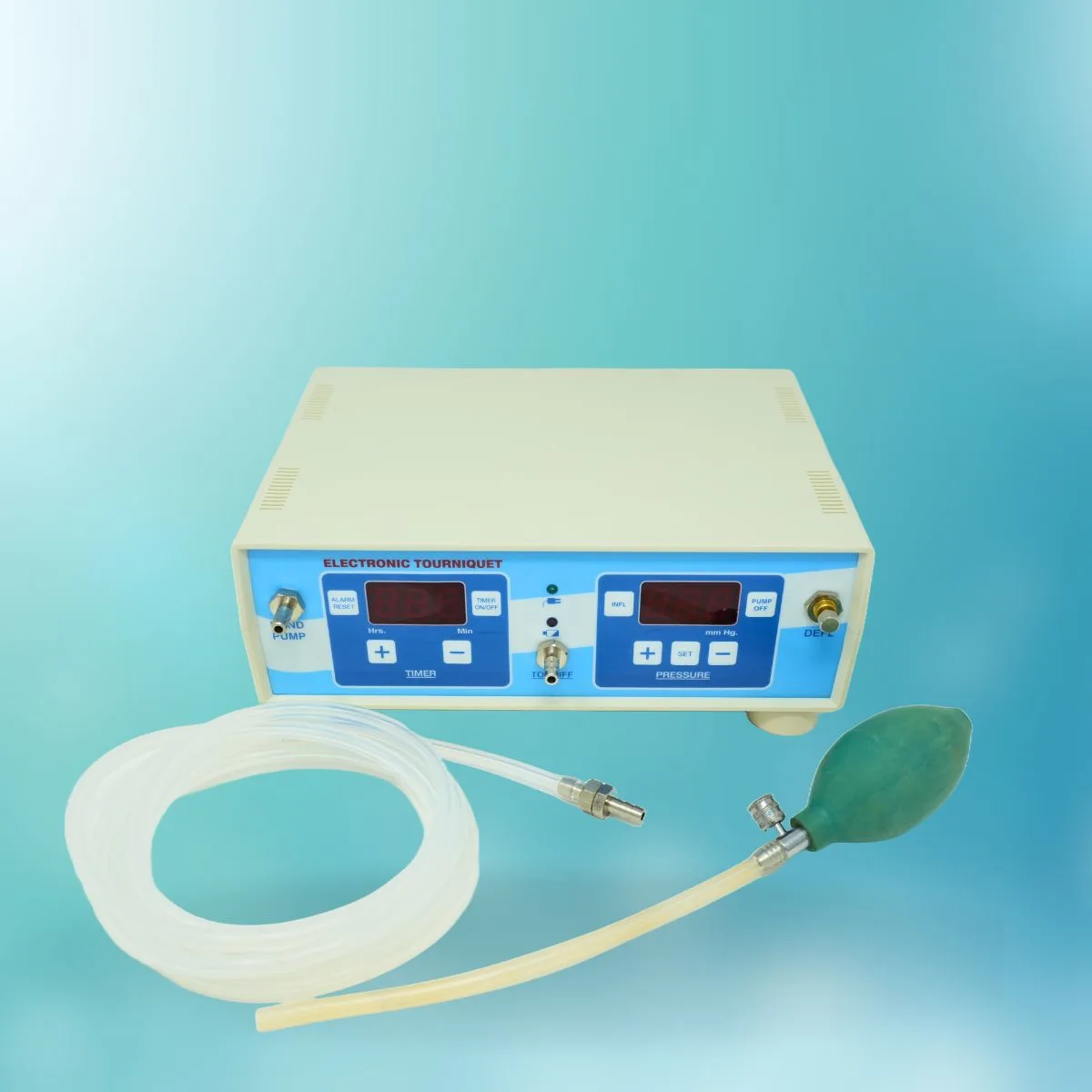TOURNIQUET
Description
A tourniquet is a medical device used in orthopedic surgeries and emergency care to control blood flow to a specific area of the body by applying controlled pressure to blood vessels, typically at the site of injury or surgery. Its primary purpose is to prevent excessive blood loss during surgeries, trauma, or situations where there is severe bleeding, especially in limbs.
Components and Types:
Tourniquets are typically composed of a durable band or strap that can be wrapped around the limb, a fastening mechanism to secure the band in place, and an adjustable tightening device. In modern medical practice, tourniquets may come with mechanical or pneumatic systems for more precise control over pressure application.
-
Manual Tourniquet: This type of tourniquet uses a simple strap and buckle or fastening mechanism. The user manually tightens the strap to apply pressure around the limb. This type is often used for emergency situations or in settings where more advanced equipment is unavailable.
-
Pneumatic Tourniquet: A pneumatic tourniquet uses air pressure to control the amount of pressure applied to the limb. It typically includes a cuff that wraps around the limb, connected to a pressure-regulating system. Pneumatic tourniquets are commonly used in orthopedic surgeries for more controlled and adjustable pressure.
-
Elastic or Velcro Tourniquet: These types of tourniquets use stretchable materials such as elastic bands or Velcro straps, which are used to constrict the blood flow temporarily, often used in smaller surgeries or emergency settings.
Applications in Orthopedic Surgery:
-
Fracture Repairs: In orthopedic trauma cases, tourniquets are often applied to the injured limb to stop the flow of blood, allowing the surgeon to work on the fractured bone or joint without the hindrance of blood pooling in the area. This is particularly useful when working on highly vascular areas or when repairing open fractures.
-
Joint Replacements: During joint replacement surgeries (such as hip or knee replacements), tourniquets are often used to temporarily halt blood flow to the joint area. This helps the surgeon maintain a clear field of vision and work in a bloodless environment, which is essential for precision during prosthesis placement.
-
Soft Tissue Procedures: Tourniquets are also used in procedures where soft tissues need to be manipulated, such as tendon repairs or ligament reconstructions. The temporary cessation of blood flow helps reduce bleeding during these delicate surgeries.
-
Spinal and Extremity Surgeries: In surgeries involving the spine or extremities, tourniquets can be used to reduce blood flow, thus improving visibility and surgical precision. Tourniquets are especially valuable in spine surgeries that require access to deep and narrow spaces.
Mechanism and Function:
The tourniquet works by constricting the blood vessels, effectively preventing blood from flowing to the part of the body beyond the tourniquet. This is especially critical in controlling bleeding during surgeries or trauma. By controlling the blood flow, the surgeon can maintain a clear surgical site, which reduces the risk of complications such as excessive bleeding or contamination.
The tourniquet is typically applied above the site of surgery or injury and is tightened to a level where it completely restricts arterial blood flow while allowing venous blood to flow back. This creates a bloodless field, which is ideal for performing surgeries that require high precision.
Benefits:
-
Prevention of Excessive Bleeding: One of the primary benefits of using a tourniquet is its ability to stop severe bleeding. This is essential during orthopedic surgeries where cutting bone or soft tissue can lead to significant blood loss.
-
Clear Surgical Field: By stopping blood flow to the affected area, tourniquets help create a bloodless surgical field, which improves visibility for the surgeon, allowing for more precise cuts, placements, and repairs.
-
Reduced Risk of Complications: Tourniquets help reduce the risk of excessive blood loss during surgery, which can prevent complications such as hypovolemic shock, prolonged surgeries, and the need for blood transfusions.
-
Improved Surgical Precision: With a clear view of the surgical site and controlled bleeding, orthopedic surgeons can perform more accurate and efficient procedures, whether they are repairing fractures, joint replacements, or soft tissue injuries.
Considerations:
-
Proper Pressure Application: One of the key concerns with using a tourniquet is applying the correct pressure. If the tourniquet is too tight, it can cause tissue damage, nerve injury, or compartment syndrome (a condition where increased pressure within a muscle group compromises blood flow). If the pressure is too low, it may not be effective in controlling bleeding.
-
Time Limits: Tourniquets should only be used for a limited amount of time. Prolonged use can lead to tissue damage due to ischemia (lack of blood supply) and can cause complications such as muscle and nerve damage. In surgical settings, careful monitoring of tourniquet time is critical, and most guidelines recommend that tourniquets not be left in place for longer than 2 hours.
-
Potential for Nerve Damage: If a tourniquet is placed incorrectly or left on for too long, there is a risk of nerve damage. The pressure exerted by the tourniquet can compress nerves in the area, leading to numbness, weakness, or, in some cases, permanent nerve damage.
-
Risk of Compartment Syndrome: Tourniquet-induced compartment syndrome is a rare but serious complication that occurs when the blood flow is restricted for too long, leading to increased pressure within the muscle compartment. This can cause severe tissue damage, pain, and long-term disability.
-
Post-Surgery Monitoring: After the tourniquet is removed, careful monitoring of the limb is necessary to ensure that blood flow is restored without causing complications such as swelling, bruising, or tissue damage. Surgeons may employ techniques such as gradual release of the tourniquet or monitoring for signs of ischemia and compartment syndrome.
Modern Innovations:
Recent advancements in tourniquet technology have led to the development of more advanced pneumatic systems that offer precise control over the pressure applied, and automated features that allow for monitoring of tourniquet pressure and time, ensuring that they are used safely and effectively. These innovations help to minimize the risks associated with tourniquet use and improve patient safety during surgeries.
Conclusion:
The tourniquet is an essential tool in orthopedic surgery and emergency medicine. It helps to control bleeding, improve surgical visibility, and reduce the risk of complications during procedures. When used properly, tourniquets are highly effective in creating a bloodless surgical field, making them indispensable for complex orthopedic procedures such as fracture repairs, joint replacements, and soft tissue surgeries. However, careful consideration must be given to the pressure, duration of use, and the timing of the tourniquet's application to avoid complications such as tissue damage or nerve injury. The development of modern pneumatic tourniquets has further enhanced safety, providing surgeons with more control and precision during their procedures.


